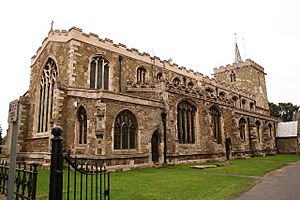St Mary's Church, Horncastle facts for kids
Quick facts for kids St Mary's Church, Horncastle |
|
|---|---|

The church's west facade, facing the market place
|
|
| OS grid reference | TF 25855 69555 |
| Country | |
| Denomination | Church of England |
| History | |
| Dedication | St. Mary |
| Administration | |
| Parish | Horncastle |
| Deanery | Horncastle |
| Diocese | Lincoln |
| Province | Canterbury |
St. Mary's Church is a very old church located in Horncastle, England. It was built a long time ago, in the early 1200s. This church is named after Saint Mary. It is an important building for the local community in Horncastle. The church is also a special "listed building," which means it's protected because of its history and architecture. A person named Ewan Christian helped restore and fix up the church between 1859 and 1861.
Contents
History of St. Mary's Church
It is believed that a very old Roman church once stood where St. Mary's Church is today. Later, a Saxon Minster (an early type of church) might have been built there. The church building you see now started to be built around the year 1250.
Major Restorations of the Church
The church has been repaired and updated two main times:
- The first big repair happened around 1660. This was led by The Rev'd Thomas Gibson. He had faced difficulties during the English Civil War but returned to his role. A special plaque on the south wall remembers his work.
- The second major restoration took place between 1859 and 1861. This important work is remembered by a beautiful stained glass window. The Rev'd Canon W H Milner was the main person who pushed for this restoration.
St. Mary's Church is still used regularly by the local community. Since 2001, a Roman Catholic group has also used the building for their services on Saturday evenings.
Architecture and Design
The church building shows three main styles of design:
- Early English: You can see this style in the main area of the church, called the nave. Look for the tall, narrow windows, called lancet windows, on the west side.
- Perpendicular: This style is clear in the north and south chapels near the altar. It also appears in the upper windows of the nave, which were added in the 1400s.
- Victorian Restoration: Many parts of the church were updated during the Victorian era. This includes the large window at the east end, the main arch, and the side aisles. During the 1859-61 restoration, the floor at the east end was raised to make space for a heating system.
You can also find some Georgian influences in the church. For example, there is a special basin called a piscina in the south wall of the chancel. This basin was used for washing communion vessels.
Church Governance and Groups
Horncastle Parish is part of a larger group of churches called the South Wolds Group. This group officially started in 2010. It helps different churches work together. This larger group is divided into three smaller parts:
- The Asterby Group
- The Hemingby Group
- The Horncastle Group
Notable Past Clergy
Many important people have served as clergy (church leaders) at St. Mary's Church. Some of them went on to hold very high positions in the church. These include:
- John Langton, who later became a Bishop.
- Simon Islip, who later became Archbishop of Canterbury.
- William Strickland, who later became a Bishop.
- Joseph Robertson, who was Vicar starting in 1779.
- Sidney Clarke, who later became the Chaplain-in-Chief of the RAF.
Monuments and Burials
St. Mary's Church is also the resting place for several notable people. Their monuments and burial sites are found within the church. These include:
- Sir Ingram Hopton
- Sir Lionel Dymoke
- Jane Dymoke
- Sarah Sellwood, who was the niece of Sir John Franklin. She was also the mother of Emily, who married the famous poet Alfred Lord Tennyson.

